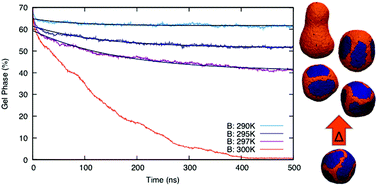Coarse-grained molecular simulations of the melting kinetics of small unilamellar vesicles†
Abstract
Simulations of small unilamellar lipid bilayer vesicles have been performed to model their response to an instantaneous rise in temperature, starting from an initial low-temperature structure, to temperatures near or above the main chain transition temperature. The MARTINI coarse-grained force-field was used to construct slabs of gel-phase DPPC bilayers, which were assembled into truncated icosahedral structures containing 13 165 or 31 021 lipids. Equilibration at 280 K produced structures with several (5–8) domains, characterized by facets of lipids packed in the gel phase connected by disordered ridges. Instantaneous heating to final temperatures ranging from 290 K to 310 K led to partial or total melting over 500 ns trajectories, accompanied by changes in vesicle shape and the sizes and arrangements of remaining gel-phase domains. At temperatures that produced partial melting, the gel-phase lipid content of the vesicles followed an exponential decay, similar in form and timescale to the sub-microsecond phase of melting kinetics observed in recent ultrafast IR temperature-jump experiments. The changing rate of melting appears to be the outcome of a number of competing contributions, but changes in curvature stress arising from the expansion of the bilayer area upon melting are a major factor. The simulations give a more detailed picture of the changes that occur in frozen vesicles following a temperature jump, which will be of use for the interpretation of temperature-jump experiments on vesicles.



 Please wait while we load your content...
Please wait while we load your content...